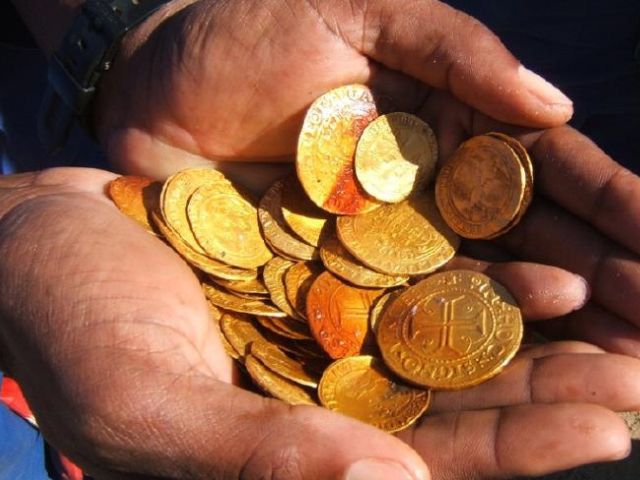
-
Archaeology
-
Inside The Centuries-Old Treasure-Laden Ship Unearthed In The Namibian Desert [Video]
16 Jul 2024 by Maya-Rose Torrao / No Comments
The ship’s cargo included 2,000 pure gold coins and tens of thousands of pounds of copper ingots, almost all intact and sparkling beautifully in the Namibian sun.
-
Interesting Developments Regarding UK’s Infamous Nude Giant Chalk Figure
13 May 2021 by Tayla / No Comments
The figure, carved into a hill in the English countryside, has recently undergone scientific testing, shedding light on its origins.
-
That Took A While: They’ve Worked Out Where The Stonehenge Stones Are From
31 Jul 2020 by Carrie / No Comments
After years of studies, scientists believe that they’ve solved the mystery of where Neolithic people sourced the stones used to make Stonehenge.
-
Archaeologists Astonished By New Discovery Near Stonehenge
22 Jun 2020 by Carrie / No Comments
Archaeologists are describing their new discovery as the “largest prehistoric structure ever found” in Britain.
-
Terrifying Archaeology Find Of Babies Wearing Helmets Made From Skulls Of Other Children
22 Nov 2019 by Carrie / No Comments
Archaeologists have been left with “many questions”, following a strange discovery in a pair of funerary mounds.
-
Wait, They Found A 15 000-Year-Old Mammoth Trap?
07 Nov 2019 by Carrie / No Comments
How we think about the mammoth has changed considerably over the millennia. Many years ago, it was quite a catch.
-
Archaeologists Left Red-Faced After ‘Ancient Stone Circle’ Revealed To Be Joke
22 Jan 2019 by Carrie / No Comments
Archaeologists were elated at the discovery of what they thought was a 4 500-year-old stone circle. This didn’t end well for them.
-
They’re Not Done Finding Ancient Hidden Cities – Look At This
14 Jun 2016 by Jasmine Stone / No Comments
If you have ever laid eyes on Angkor Wat you’ll know it’s a thing of real beauty, but now a new discovery is shaking up everything historians thought they knew.
-
They Found A Skull In Noordhoek Sand Dunes This Weekend
21 Apr 2015 by Kiernan / No Comments
Residents of Noordhoek got more than they bargained for when they found a skull during a beach clean-up over the weekend.
-
1160 Murdered King’s Coffin Opened – This Is What They Found
25 Apr 2014 by Jasmine Stone / No Comments
Archaeologists have opened the coffin of Swedish king Erik IX, who was murdered in 1160, to examine his DNA. While that in itself is pretty awesome, the stuff they found inside his casket was better.
-
They’ve Found An Ancient City Beneath These Biblical Era Ruins
18 Nov 2013 by Jasmine Stone / No Comments
It’s tough being an archaeologist. You spend months out in the field trying to pick away the sands of time, often finding nothing. And even when you do find something, it’s tough to get people excited. Well, the hard work may have paid off, as archaeologists have uncovered an entire city in the dust of Israel.
-
Sorry Guys, Stonehenge Had Nothing To Do With Weird Rituals
10 Sep 2013 by Jasmine Stone / 1 Comment
Nope, Stonehenge wasn’t used as a setting for sun-worshipping or sacrifices, as much as we wish it had been. Archaeologists have just unearthed a missing “piece of the jigsaw” to shed light on the real purpose of England’s greatest prehistoric site.
-
Incredible Photos From Egypt’s Lost City Of Thonis-Heracleion [GALLERY]
30 Apr 2013 by Jasmine Stone / No Comments
Heracleion was once believed to be nothing more than a myth, a legend set far beneath the blue ocean. Ten years after divers stumbled upon its treasures deep beneath the ocean, archaeologists have produced a scientific rendering of what life in the city may have looked like.
-
Site Of Julius Caesar’s Stabbing Discovered
12 Oct 2012 by Jasmine Stone / 2 Comments
Julius Caesar, the most prominent and famous of all the Roman rulers was stabbed on the 15th of March, 44BC – known as the Ides of March. We know this thanks to the many classical texts detailing the event. For the first time, archaeologists suspect they may have found physical evidence.
-
Italian Archaeologists Claim To Have Discovered The Real Mona Lisa’s Skeleton
19 Jul 2012 by Jasmine Stone / No Comments
Archaeologists, working in Florence, are convinced that they have uncovered the remains of the woman believed to have posed for Leonardo Da Vinci’s famed Mona Lisa portrait.
-







































